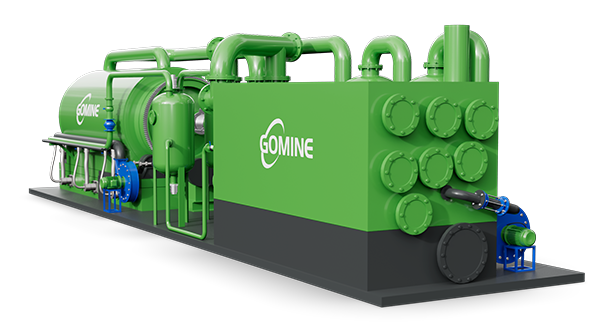As global plastic pollution becomes increasingly serious, traditional mechanical recycling methods face many challenges, such as plastic degradation, contamination, and difficulty in separating mixed materials. Pyrolysis technology, as an advanced chemical recycling method, decomposes waste plastics into high-value products such as fuel oil, combustible gas and carbon black in a high-temperature, oxygen-free environment, providing a new solution for the resource utilization of plastic waste.

Types of Plastics Suitable for Pyrolysis Recycling
- Polyethylene (PE): including high-density polyethylene (HDPE) and low-density polyethylene (LDPE), commonly found in plastic bags, bottles and packaging films.
- Polypropylene (PP): used in food containers, bottle caps and automotive parts, etc.
- Polystyrene (PS): such as foam plastics, disposable tableware and packaging materials.
- Acrylonitrile-butadiene-styrene copolymer (ABS): widely used in electronic product housings, toys and automotive parts.
These plastics have a high oil yield during pyrolysis, and high-purity raw materials can achieve an oil yield of more than 90%, which is suitable for fuel oil production.

Types of Plastics Not Suitable for Pyrolysis Recycling
Some plastics will produce harmful substances or cause equipment corrosion during pyrolysis, so they are not recommended:
- Polyethylene terephthalate (PET): Commonly used in beverage bottles and food packaging. During pyrolysis, PET produces waxy byproducts and harmful gases such as benzene and acetaldehyde, and has low oil yield and poor economic benefits.
- Polyvinyl chloride (PVC): Used for pipes, floors, cable sheaths, etc. PVC contains a large amount of chlorine, which releases highly corrosive hydrogen chloride (HCl) gas during pyrolysis, causing equipment corrosion and possibly generating toxic dioxins, increasing the difficulty and cost of processing.
Key Steps in Plastic Pyrolysis Recycling
- Raw material pretreatment
Classification and screening: Classify waste plastics by type, remove plastics (such as PVC, PET) and impurities that are not suitable for pyrolysis, so as to improve pyrolysis efficiency and product quality.
Cleaning and drying: Remove dirt, moisture and other impurities on the surface of plastics to prevent adverse reactions during pyrolysis.
Crushing and pulverization: Crush plastics into particles of appropriate size for subsequent heating and reaction.
- Pyrolysis reaction
Heating decomposition: In an oxygen-free or micro-oxygen environment, heat the pretreated plastic to 300°C to 900°C to break the polymer chain and convert it into small molecular compounds.
Reaction control: Optimize the composition and yield of the product by controlling the temperature, heating rate and reaction time.
- Product condensation and collection
Gas condensation: The gas generated by pyrolysis is cooled through the condensation system to collect liquid fuel oil.
Carbon black collection: The solid residue after pyrolysis is mainly carbon black, which can be used to make rubber products, inks, etc.
Combustible gas utilization: Uncondensed combustible gas can be reused as energy in the pyrolysis process to reduce external energy consumption.
- Waste gas treatment and environmental control
Gas purification: Remove harmful gases and particulate matter through processes such as deacidification, dust removal, and adsorption to ensure that emissions meet environmental standards.
Wastewater treatment: The wastewater generated during the treatment process needs to be purified to prevent pollution to the environment.
Application Fields and Market Prospects of Plastic Pyrolysis Plants
Urban solid waste treatment centers: help cities achieve harmless and resourceful treatment of waste plastics.
Plastic recycling companies: increase the added value of recycled plastics and expand product application areas.
Energy production companies: convert waste plastics into renewable energy and reduce dependence on fossil fuels.
Technical Parameters of Plastic Pyrolysis Plant
| Models | Batch Design (GM-BLJ-5) | Semi-Continuous Design (GM-SLJ-15) | Continuous Design (GM-CLJ-20) |
| Unit Capacity | 5~20 Tons/day | 15~25 Tons/day | 20~70 Tons/day |
| Feedstock Size | ≤1600mm | ≤100mm | ≤80mm |
| Feedstock Pretreatment | – | Need to be pre-processed by shredder or grinder to the appropriate size | Need to be pre-processed by shredder or grinder to the appropriate size |
| PLC | Optional | Optional | Equipped with |
| Reactor Cooling Time | 3~12 hours | 3~5 hours | 0 |
| Power | 12~25 kW/h | 15~30 kW/h | 50 kW/h |
| Maintenance Period | 1 day | 7~10 days | 45~60 days |
We are experts in the field of solid waste recycling especially metal recycling. We can provide a complete set of solutions, including waste cable recycling, waste circuit board recycling, metal and non-metal crushing and sorting, mixed plastic recycling, etc. If you have any need of our machine, feel free to contact Gomine Machinery.


